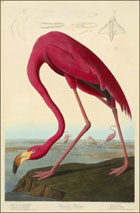Products |
Discovery Editions

By
Published: Jan 01, 2007
Category:
Art
Want to buy a painting by an artist with any reputation? No longer possible. Once the rich had bought enough real estate to hold them for a few years, they turned to art. And, predictably, prices zoomed.
Well, what about photography? That was our thought as the millennium ended. And thank heaven we bought the few photos we did, because in the last few years the semi-rich who couldn’t buy paintings swept into the photo galleries. And, predictably, prices zoomed.
And there you are, with empty space on your walls, a large appetite for beauty and not much interest in flinging up the fading posters of your college days.
Richard Sandhaus has a solution — the great birds of John James Audubon, the eye-stopping botanical watercolors of Pierre-Joseph Redouté, and rare maps from the great days of exploration.
Copies, of course. But exact copies, with what he calls “absolute visual identity — which is what you expect from reproductions made on a scanner so big “you could put a Mini Cooper in it” and so slow that it seems barely to move in an hour. How good are these reproductions? Aficionados of original Audubons and Redoutés buy them to fill in their collection or for their second (or third) homes.
On my iMac screen, all art looks vivid, so I hiked down to meet Richard Sandhaus and see the work with clean glasses and critical eyes. Along the way, I got an education about the history of these magisterial pieces — and the path that led Sandhaus to them.
Richard Sandhaus is one of those vexingly organized, accomplished people who would be hateful if he weren’t so damned nice. As a high school kid, he was a major rock music promoter in Connecticut; at Amherst College, he was a powerhouse across New England. After graduation, he continued his bifurcated path, doing anthropological field research on a small island in the Territory of Papua New Guinea and, back in New York, producing records and video. He segued into making laser and multimedia shows, and soon had clients like the Olympics and the Super Bowl. And then he took his interest in collecting antique maps and botanicals, married it to his two decades in technology, and developed a digital process that could exactly replicate antique works on paper.
His timing is impeccable, for botanicals, birds and maps are following painting and photography out of most collectors’ price range. “I bought a hand-colored Redouté engraving eight years ago for $6,000,” he told me. “Now that would be $40,000. And this is happening so dramatically across the board that I thought: What if you could — legitimately — copy that work so people who were priced out of market could enjoy it?”
Happily, Sandhaus was already a client of W. Graham Arader III, the acknowledged king of dealers in Audubon and Redouté, so he was able to get access to a large selection of these artists’ work. In 2006, he stepped into what just might be his final incarnation: founder of DiscoveryEditions.com.
From looking at these images, I can attest: the closer you come, the better they look. Audubon’s flamingo is a shock of color, a visual wake-up call; the white pelican looks as if it’s starring in a black-and-white movie. An original engraving of the Redouté pineapple can cost $750,000, and, looking at it, you can easily see why — it’s so accurate and realistic it’s photographic. The Parrot Tulip by Maria Merian is of interest not only for its beauty, but also for the artist herself; Merian was the first great female botanical painter. As for the maps, the one of Central Park in 1865 doesn’t quite show the five million trees — but it surely suggests them. And the bird’s eye view of San Francisco in 1878 is literally that; it’s what the city would look like from a hot air balloon.
Reproductions come, as you may know, at all levels of price and quality. The trick is to find high quality and a reasonable price. I have done my due diligence, and I can attest: Not only can’t you get some of these images for less, most have never been reproduced before. The Redouté and Merian, for example, are exclusive, first-ever reproductions of the original watercolors.
Discovery Editions is Head Butler’s first foray into fine art. I’m glad I waited. This is work that has integrity, value, durability — and delight.
To buy the Pink Flamingo, click here.
To buy the White Pelican, click here.
To buy the Redouté Pineapple, click here.
To buy Merian’s Parrot Tulip, click here.
To buy the 1865 Map of Central Park, click here.
To buy the 1878 birds-eye view of San Francisco, click here.
To visit Discovery Editions, click here.

